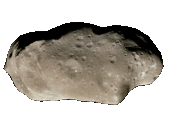Asteroids
Barely a century ago, the solar system seemed a very simple place, containing eight large planets, together with their thirteen moons moving on prograde orbits. Additionally, the solar system of the last century contained a belt of asteroids or minor planets lying between Mars and Jupiter and occupying the predicted position of a large planet as given by the empirical Titius-Bode law.
 This simple picture has been gradually disrupted. First, moons of the size of asteroids were discovered - like Phobos and Deimos, the two satellites of Mars. Second, retrograde moons like Triton (the largest moon of Neptune) and Amalthea (the fifth satellite of Jupiter) were found. Wolf, in 1907, discovered the first Trojan asteroid. This shares Jupiter's orbit, but moves 60 degrees ahead of the planet. Now a few hundred of these Trojans are known, occupying the Lagrange points discovered in the restricted three-body problem by the famous mathematician Joseph Lagrange. Near-Earth objects were uncovered in 1898, when two astronomers independently spotted 433 Eros, whose orbit lies inside that of Mars. In 1932, the asteroid 1862 Apollo was found interior to the Earth's orbit. By then, the neat picture of a Main Belt of asteroids as remnants of a giant planet that occupied the region between Mars and Jupiter had been overturned. Although most of the asteroids do indeed occupy the Main Belt, many are now known to reside in interplanetary space as well.
This simple picture has been gradually disrupted. First, moons of the size of asteroids were discovered - like Phobos and Deimos, the two satellites of Mars. Second, retrograde moons like Triton (the largest moon of Neptune) and Amalthea (the fifth satellite of Jupiter) were found. Wolf, in 1907, discovered the first Trojan asteroid. This shares Jupiter's orbit, but moves 60 degrees ahead of the planet. Now a few hundred of these Trojans are known, occupying the Lagrange points discovered in the restricted three-body problem by the famous mathematician Joseph Lagrange. Near-Earth objects were uncovered in 1898, when two astronomers independently spotted 433 Eros, whose orbit lies inside that of Mars. In 1932, the asteroid 1862 Apollo was found interior to the Earth's orbit. By then, the neat picture of a Main Belt of asteroids as remnants of a giant planet that occupied the region between Mars and Jupiter had been overturned. Although most of the asteroids do indeed occupy the Main Belt, many are now known to reside in interplanetary space as well.
New classes of asteroid
 The last few decades have seen further new classes of objects discovered in the Outer Solar System. The first class are the Centaurs, that occupy the domain between Saturn, Uranus and Neptune. They have physical characteristics intermediate between asteroids and comets. For example, the first Centaur, Chiron, has the typical colours of an asteroid but the characteristic coma of a comet. The orbits of the Centaurs are likely to be unstable on long timescales, as they are planet crossing. The second class are the Kuiper-Edgeworth Belt objects. These are still more distant, located beyond the orbit of Neptune. Over a hundred of these objects are now known, many of them trapped in the same resonance with Neptune as Pluto. In fact, Pluto itself is now believed to be simply the largest and most prominent member of the Kuiper Belt objects.
The last few decades have seen further new classes of objects discovered in the Outer Solar System. The first class are the Centaurs, that occupy the domain between Saturn, Uranus and Neptune. They have physical characteristics intermediate between asteroids and comets. For example, the first Centaur, Chiron, has the typical colours of an asteroid but the characteristic coma of a comet. The orbits of the Centaurs are likely to be unstable on long timescales, as they are planet crossing. The second class are the Kuiper-Edgeworth Belt objects. These are still more distant, located beyond the orbit of Neptune. Over a hundred of these objects are now known, many of them trapped in the same resonance with Neptune as Pluto. In fact, Pluto itself is now believed to be simply the largest and most prominent member of the Kuiper Belt objects.
Asteroids are now believed to be remnant planetesimals. The fate of most planetesimals was to accumulate into larger and larger bodies, which became the planets. Some of the plenetsimals, instead of accumulating, struck each other, resulting in fragmentation rather than coalescence. The reservoir of asteroids that persists to this today are simply the remnant planetesimals that have endured the gravitational forces of the planets and the destructive effects of collisions for billions of years. The reservoir is greatest in those regions of the Solar System where long-lived orbits may presist - such as the Main Belt between Mars and Jupiter and the Kuiper-Edgeworth Belt beyond Neptune. Leakage from these belts can occur, creating itinerant bodies that may supply the population of near-Earth objects or be captured by the planets as possible small moons.
